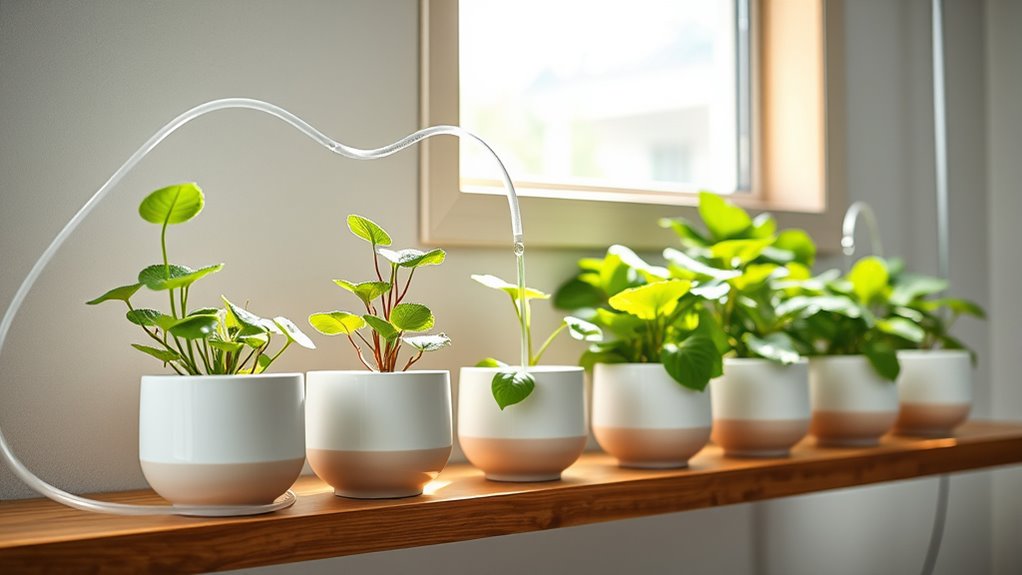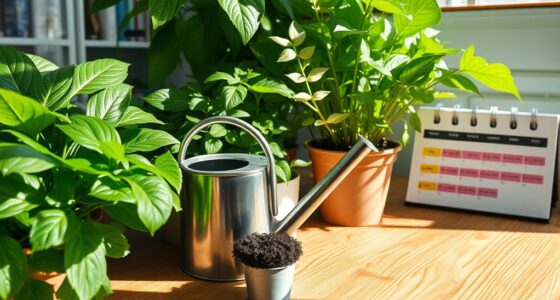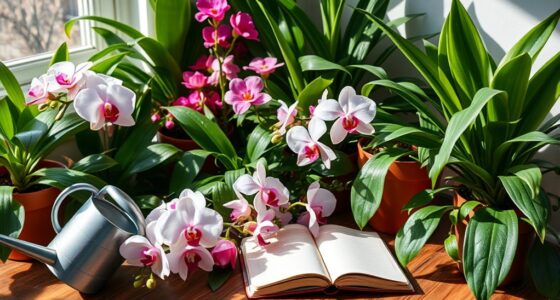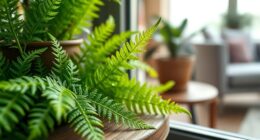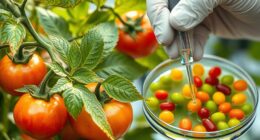To vacation-proof your indoor plants, set up an automated watering system with moisture sensors and adjustable timers. These systems activate watering only when soil moisture drops below your chosen level, preventing over- or underwatering. Group plants with similar needs and consider their placement to tailor schedules, especially in high-traffic or dry areas. Environmental factors like humidity and drafts also matter. Keep exploring to discover how to optimize your setup for stress-free plant care during summer trips.
Key Takeaways
- Install automated watering systems with moisture sensors that activate only when soil moisture drops below set levels.
- Adjust timers based on plant placement, considering sunlight and humidity to prevent over- or underwatering.
- Group plants with similar water needs for easier automation and consistent care during your absence.
- Check soil moisture a few inches below the surface before leaving to set appropriate watering thresholds.
- Consider environmental factors like drafts and humidity, and modify automation settings to maintain optimal moisture levels.

Are you worried about leaving your indoor plants unattended during your next vacation? It’s a common concern, especially when you want to keep your greenery healthy without constant oversight. The key to successful plant care while you’re away lies in understanding soil moisture and plant placement. These factors determine how well your plants tolerate periods of neglect and how effectively automated irrigation systems can keep them thriving.
First, consider soil moisture. Healthy plants depend on consistent moisture levels, but overwatering can be just as harmful as underwatering. Before you leave, check the soil moisture of each plant. If the soil feels dry a couple of inches below the surface, it’s a good idea to set up an automated watering system that delivers just enough water to maintain ideal soil moisture. Many systems come with adjustable timers and moisture sensors, ensuring your plants get the right amount of hydration without the risk of overwatering. These sensors detect moisture levels and activate watering only when necessary, saving water and preventing root rot. Proper soil moisture management through automation means you don’t have to worry about your plants drying out or drowning while you’re away.
Next, think about plant placement. The location of your indoor plants influences their water needs and overall health. Plants placed near windows or in direct sunlight typically require more frequent watering because they lose moisture faster through evaporation. Conversely, plants tucked away in low-light corners need less water and are often more forgiving during short absences. When setting up automated irrigation, consider each plant’s placement to customize watering schedules accordingly. For instance, a sun-loving plant on a south-facing windowsill might need more frequent watering than a shaded fern in a corner. Strategically grouping plants with similar needs can simplify automation and ensure they’re all adequately cared for during your trip.
Additionally, think about the environment where your plants are situated. High humidity levels or drafts from air conditioning or heating can affect soil moisture and plant health. Automating watering in a well-ventilated, stable environment reduces the risk of stress or dehydration. By understanding your plant placement and adjusting watering schedules based on their specific needs and conditions, you create a more resilient system that can handle various scenarios. Incorporating knowledge of Kia Tuning concepts like suspension and environment adaptation can help optimize your system for better plant health during your absence.
Frequently Asked Questions
How Do Automated Irrigation Systems Differ for Various Plant Types?
When it comes to automated irrigation systems, you can customize watering schedules based on your plant types. Some plants need more frequent watering, while others prefer less. You’ll want to adjust the system for plant type customization, ensuring each gets the right amount of water. Regular watering schedule adjustments keep your indoor plants healthy, preventing overwatering or underwatering, especially during times when you’re away.
Can Automated Systems Detect Overwatering or Underwatering Issues?
Some automated systems claim they can detect overwatering or underwatering, but their accuracy depends on sensor calibration. You should verify if the sensors are correctly calibrated for your plant types, as improper calibration can lead to inaccurate watering. While these systems can monitor soil moisture levels and adjust watering accordingly, they aren’t foolproof. Regularly checking and maintaining sensor calibration guarantees better watering accuracy and healthier plants.
What Is the Typical Lifespan of an Automated Irrigation Device?
Automated irrigation devices typically last between 3 to 7 years, depending on their build quality and usage. You should regularly check their watering schedules and maintain device durability by cleaning and replacing parts as needed. Proper care guarantees your system functions efficiently during your trips, preventing overwatering or underwatering. Investing in a high-quality device and following maintenance tips can extend its lifespan, giving you peace of mind when you’re away.
Are There Eco-Friendly Options for Indoor Plant Watering Systems?
Imagine a garden whispering eco-friendly secrets. You can choose indoor watering systems crafted from sustainable materials and biodegradable components, making your plant care greener. These options reduce plastic waste and environmental impact while keeping your plants healthy. By selecting eco-conscious devices, you’re not just watering your plants; you’re nurturing the planet, ensuring that your indoor oasis remains vibrant and sustainable for years to come.
How Do I Troubleshoot if My Automated System Stops Working?
If your automated system stops working, start by checking the power source and connections. Then, manually adjust the system settings and recalibrate sensors if needed. Make sure the sensor is clean and correctly positioned, as dirt or misplacement can cause malfunctions. Test the system after these adjustments. Regular maintenance and sensor calibration help guarantee your indoor plants stay watered during your trips.
Conclusion
By setting up automated irrigation, you protect your indoor plants from drought, damage, and neglect. You guarantee they thrive, survive, and stay healthy while you’re away. You enjoy your trip worry-free, confident in your system’s reliability. You return home to vibrant, happy plants, ready to reconnect. Vacation-proofing isn’t just about convenience; it’s about peace of mind, preservation, and the joy of caring for your indoor garden—no matter where your adventures take you.

